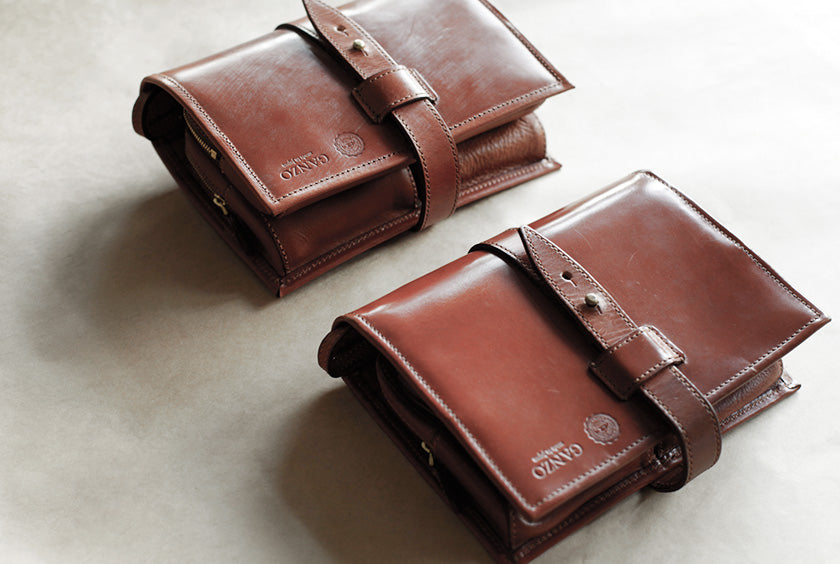BRIDLE LEATHER


BRIDLE LEATHERThe makings of durable, water-resistant bridle leather

GANZO's bridle leather goods
GANZO's products are made from bridle leather produced by J & E Sedgwick & Co. in the UK, who rely on traditional techniques and manufacturing methods handed down through generations.
The leather features "bloom," a white powder unique to bridle leather that emerges when wax is rubbed into the surface of the leather. The material is made using a traditional manufacturing method and sewn in a way that allows Japanese craftsmanship to shine through.
First there was the harness
"Bridle leather" is a general term for leathers used in harnesses that are worn on the horse's head, such as the bridle mounts ("baroku" in Japanese), the straps for the bits ("hami" in Japanese), and the reins. From these origins, the term "bridle leather" has since evolved to mean certain waxed leathers that are also used for purposes other than equestrian.
While preserving the traditional method born from the British climate
Bridle leather was created around the 14th century in England for aristocrats and other riders of horses. The reason for waxing the leather was to prevent the leather's resistance to the elements from being degraded by the rainy English climate and the sweat and saliva of the horses. Only in the last few decades has it been incorporated into common fashion as we know it today.
Traditional bridle leather manufacturing methods have become rare as it takes about 18 weeks of hard work to create bridle leather this way. However, GANZO makes it a point to use bridle leather made from traditional manufacturing methods that have been handed down over many decades.

Strong, flexible, and beautiful
Bridle leather was originally made for harnesses and reins to restrain horses, so it's important that it offers strong tensile strength. Leather becomes softer when oil is added. Bridle leather itself must be hard and sturdy, but removing the oil will cause the leather to crack.
Oil is therefore applied only to the surface of the leather to keep the surface supple and the coarse fibers under the skin intact and strong. The addition of wax makes the leather soft and waterproof.
Leather produced by tanning over a long period of time
The tanning process is carried out using a tanning device made of oak, commonly known as a "drum."
As the name implies, vegetable tannin is used for the tanning process.
This tannin is derived from oak bark, and is one of the hardest vegetable tannins available.
-
The work of a tanner
A tanner is a person who tans leather. Dyeing is also done manually by tanners. Dye is soaked into a sponge and applied evenly onto the leather to give it depth. After this process is repeated, the leather is repeatedly brushed with a special wax blended with tallow, cod oil, and beeswax. The distribution of beeswax is changed depending on the season, and the characteristic "bloom" or pull-up of the bridle is brought out to produce a unique texture.
-
Currying
The tanner who finishes the leather is called a currier. It's the job of the tanner to flatten the surface of the three-dimensional hide. The tanner uses a tool called a slicker to stretch the leather and remove the surface skin to reveal the dermis.
-
Buffing
After the currying process, the leather is buffed, which involves rubbing the surface of the leather. If the leather is rubbed too much, it will become fluffy and nubuck-like, losing its sheen on the surface and weakening the leather itself. On the other hand, if the leather is not rubbed, the oil and dyes will not be able to penetrate. After flattening the leather, the leather is finished with sandpaper and other materials while carefully and repeatedly making fine adjustments along the way.
Making the most of ancient
technology today
Since bridle leather is hard and contains oil, it's not suited for hemming and does not accept adhesives well. In order to leverage the beauty of this fine quality leather, GANZO uses a combination of cut finishing and sewing.
GANZO products use genuine leather for the lining to further polish the edges. The personality of the products shines through, thanks to ages-old technologies.


Attention to detail gives life to the product
GANZO wallets are beautifully organized in a streamlined shape when viewed from the side. In order to create this form, craftsmen make a paper pattern, cut the material while observing the leather fibers, and work the leather while taking the elasticity of the bridle into account.
This kind of craftsmanship and persistence is the essence of GANZO.

Leather that matures with the warmth of people
Bridle leather is a material that changes over time. Unlike nubuck, bridle leather originally contains a lot of wax and oil, so just by using it every day, the wax and oil becomes more acclimated to the leather, giving it a deeper sheen and a more comfortable feel.

A look that changes over time
The white powder called "bloom" that seeps out from the surface of the leather is the most distinctive feature of bridle leather. As the "bloom" becomes more acclimated to the leather, you will be able to enjoy the rich look of the leather as it ages.
Bridle leather products will actually change in appearance as they are used, offering more enjoyment as they also last longer than other leather products.
Day-to-day care
Bridle leather contains oils and waxes to begin with, so as you use it over time, it keeps its luster while being supplemented by the oil from your hands. Just wipe it dry with a natural fiber cloth or brush, and the wax will penetrate into the necessary areas to bring out the luster without much effort.







